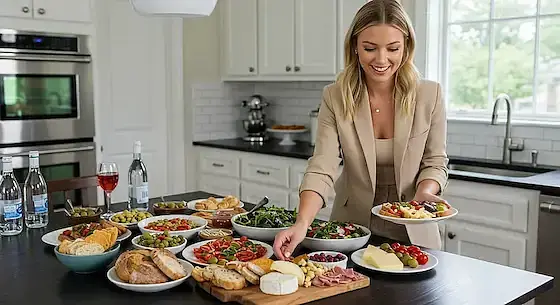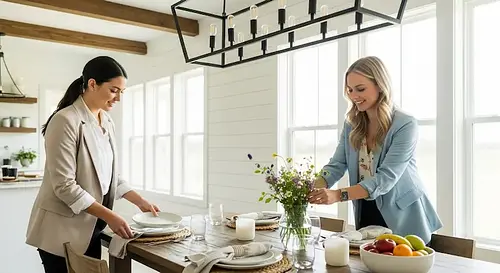Open House Food Ideas: Snacks, Finger Foods & Refreshments That Sell
Discover the best open house food ideas, including snacks, finger foods, refreshments, and sample menus. Learn what to serve at an open house to impress buyers and spark offers.

Written by Seth Cox
Jun 04, 2025 / Open house marketing
In this guide, we’ll explore open house food ideas that are easy to serve, mess-free, and memorable. You’ll learn what to offer based on the time of day, season, and type of property, along with best practices for presentation and promotion. Let’s turn your next open house into an experience buyers won’t forget.
Why Food Matters at an Open House
First Impressions Are Often Tied to the Senses
- Use inviting aromas to create an emotional connection with the space.
- Display finger foods near the entrance to welcome visitors immediately.
- Choose attractive, minimalist presentation for a clean first impression.
- Match the food to the home’s style to reinforce the property’s personality.
- Encourage guests to linger, boosting your chances of meaningful conversations.
The Psychology Behind Serving Food at Open Houses
- Buyers are more receptive when their comfort needs are met.
- A thoughtful snack setup makes your event feel intentional and polished.
- The best food for open house showings is low-pressure and low-mess.
- Food encourages longer stays and deeper emotional engagement with the property.
- Adding food to your open house plan increases perceived value.

Open House Food Planning Tips
Keep It Simple and Mess-Free
- Avoid anything sticky, greasy, or crumbly.
- Use toothpicks, skewers, or cupcake liners for single-serve presentation.
- Choose foods that don’t require refrigeration during your showing.
- Place napkins and trash bins nearby for easy cleanup.
- Limit food to one central location, such as the kitchen island or dining table.
Time of Day Determines What You Serve
- Morning: pastries, fruit, coffee, yogurt cups.
- Afternoon: cookies, cheese boards, iced tea.
- Evening: hors d’oeuvres, wine (where appropriate), mini desserts.
- Avoid large meals or anything requiring a plate and fork.
- Always consider prep time and perishability.
Think About Allergies and Dietary Needs
- Offer one nut-free and one gluten-free option if possible.
- Label any items with allergens (nuts, dairy, gluten, etc.).
- Keep ingredients simple and avoid strong spices or sauces.
- Avoid overly niche foods that may alienate guests.
- Consider adding a small sign: “Snacks available—please help yourself!”
Best Food Ideas for Morning Open Houses
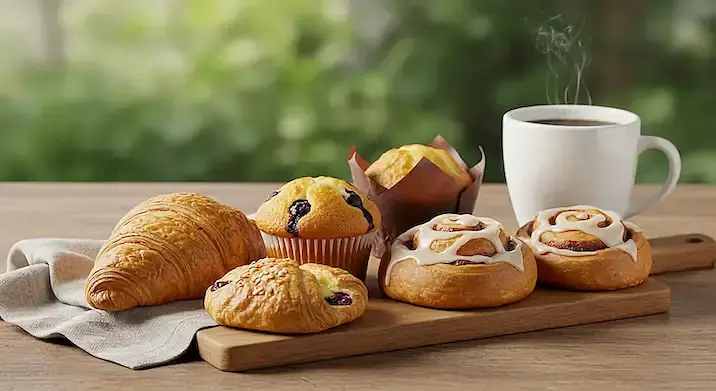
Coffee and Breakfast Pastries
- Brew fresh drip coffee or offer individual bottled cold brews.
- Serve mini croissants, danishes, or cinnamon rolls in bite-size portions.
- Provide stirrers, lids, napkins, and disposable cups with sleeves.
- Keep a trash bin nearby for used stir sticks and wrappers.
- Use a tiered tray to elevate presentation on a small counter.
Yogurt Parfaits and Fruit Cups
- Use clear plastic cups for layered parfaits with granola topping.
- Offer fruit cups with grapes, melon, pineapple, and berries.
- Include small spoons in each cup to minimize mess.
- Keep cold using a shallow ice tray under your serving surface.
- Label ingredients in case of allergies or dietary preferences.
Bottled Smoothies and Muffin Minis
- Buy pre-bottled smoothies in a variety of flavors.
- Serve mini muffins in flavors like blueberry, banana, and lemon poppyseed.
- Place everything in a shallow basket or tray for easy access.
- Include a simple sign that says “Help yourself—enjoy the tour!”
- Consider a small cooler for longer open house durations.
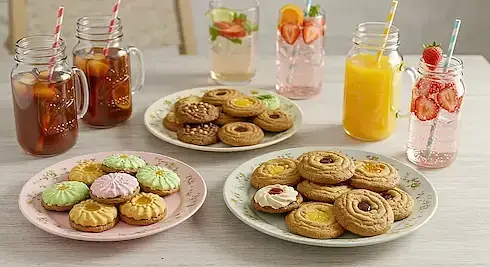
Best Food Ideas for Afternoon Open Houses
Cookie Platters and Cold Drinks
- Offer bite-sized cookies like chocolate chip, oatmeal, or sugar.
- Include sparkling water, lemonade, or bottled iced tea in a cooler.
- Avoid sticky glazes or powdered sugar that can make a mess.
- Arrange cookies neatly on tiered platters or bakery paper-lined trays.
- Add a small sign: “Fresh cookies—take one and enjoy the tour!”
Cheese Boards and Light Snacks
- Include cubed cheeses, seedless grapes, and crackers in divided trays.
- Pre-slice everything to encourage one-handed grazing.
- Stick to mild flavors (cheddar, brie, mozzarella) to appeal to most guests.
- Use parchment cups or mini plates for individual servings.
- Set up near the kitchen island or dining table for convenience.
Themed Charcuterie Bites
- Assemble mini skewers with cheese, salami, and olives.
- Or use paper cups with a few rolled meats, nuts, and dried fruit.
- Add a rosemary sprig or grape for a pop of color.
- Keep portions small and simple—no knives or utensils needed.
- Display on a tray with toothpicks or grab-and-go signage.
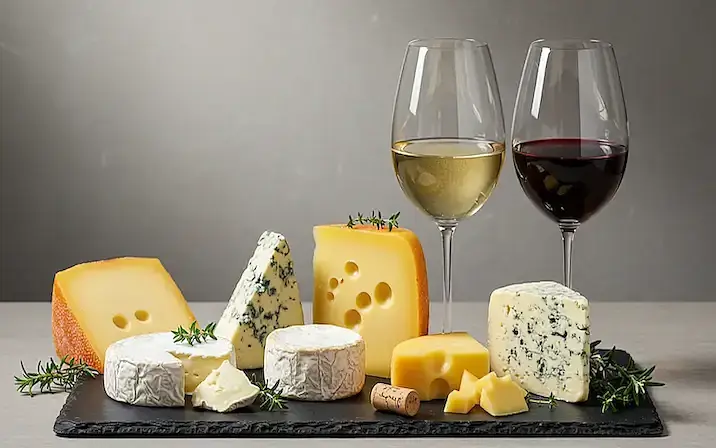
Best Food Ideas for Evening Open Houses
Wine and Cheese Pairings (Where Permitted)
- Serve one red and one white wine with small disposable cups.
- Offer mild cheeses like brie, gouda, or manchego on small platters.
- Include crackers or baguette slices arranged neatly in a tray.
- Set up a drink station near the kitchen with napkins and trash bins.
- Always check legal restrictions and have signage for age verification.
Elegant Finger Foods and Hors d’Oeuvres
- Caprese skewers with cherry tomatoes, mozzarella, and basil.
- Mini puff pastries filled with cheese or spinach.
- Cucumber rounds topped with cream cheese and dill.
- Shrimp cocktail in individual cups or spoons.
- Mini meatballs or chicken skewers served with toothpicks.
Mini Desserts and After-Dinner Treats
- Serve brownie bites, lemon bars, or chocolate-covered strawberries.
- Use small paper cups or doilies for a clean presentation.
- Add a small sign like “Enjoy a sweet treat before you leave.”
- Include bottled sparkling water or decaf coffee to complement the desserts.
- Keep the display minimal and well-lit for a high-end feel.
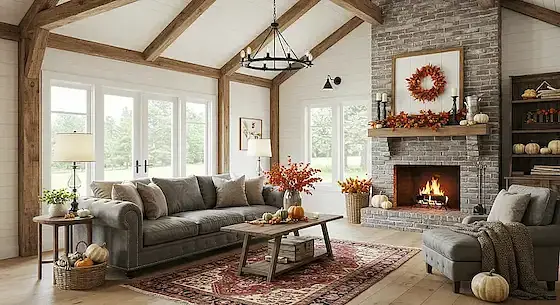
Seasonal Open House Food Ideas
Fall: Pumpkin Bread, Cider, and Mini Pies
- Serve mini slices of pumpkin bread, apple loaf, or spice cake.
- Offer hot or chilled apple cider in insulated cups.
- Use plaid napkins or a wood board for seasonal flair.
- Add mini apple or pecan pies in individual wrappers.
- Light a cinnamon-scented candle to enhance the experience.
Winter: Hot Cocoa, Cookies, and Warm Bites
- Create a hot chocolate station with marshmallows and stir sticks.
- Serve cookies like gingerbread, chocolate chip, or peppermint.
- Include savory options like mini quiches or pigs in a blanket.
- Use slow cookers or insulated trays to keep food warm.
- Decorate with subtle holiday or winter greenery.
Spring & Summer: Lemon Bars, Iced Tea, and Fresh Fruit
- Offer lemon bars, fruit skewers, or mini cupcakes.
- Provide iced tea, infused water, or lemonade in clear dispensers.
- Use white trays, florals, or citrus slices for display styling.
- Avoid melty foods that won’t hold up in heat.
- Keep napkins and wet wipes nearby for sticky fingers.
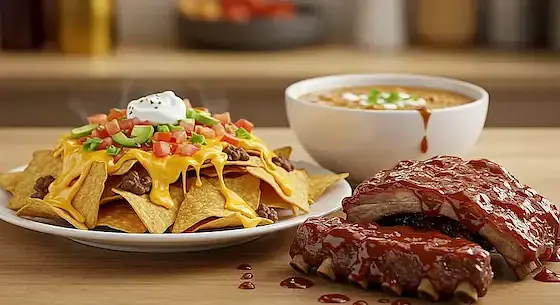
What to Avoid When Serving Food at an Open House
Strong Smells and Messy Foods
- Avoid garlic, onions, seafood, or anything fried.
- Skip saucy or greasy foods like pizza or wings.
- Don’t serve items that require cutting or full utensils.
- Keep all food confined to one area of the home.
- Choose neutral scents like vanilla, citrus, or baked goods.
Complicated Setups That Distract From the Home
- Don’t set up multiple food stations throughout the house.
- Avoid foods that require heating, constant refilling, or cleanup.
- Skip displays that crowd entryways, countertops, or staging areas.
- Keep signage and décor minimal so the home stays the focus.
- Use trays, not tables, when space is limited.
Anything That Requires a Fork and Knife
- Stick to finger foods that are easy to carry while walking.
- Avoid salads, pastas, or meals that require sitting.
- Don’t use real plates or glassware—disposables only.
- If you're not sure, ask: “Could someone eat this with one hand?”
- Keep utensil needs limited to napkins and toothpicks only.
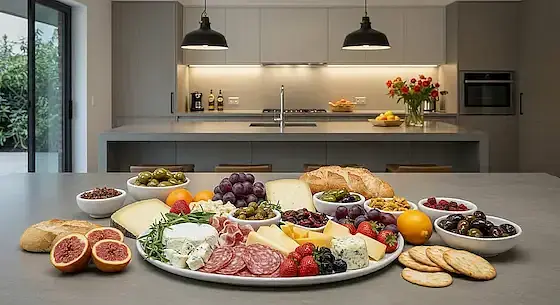
Pairing the Right Food with the Right Home
Match the Food to the Property Type
- Serve charcuterie or wine pairings in upscale, modern homes.
- Offer classic treats like cookies and lemonade in traditional family homes.
- Use local snacks for rural or small-town properties to highlight community.
- Match colors and serving pieces to the home’s décor style.
- Avoid overly formal food in casual or smaller homes.
Consider Buyer Demographics
- Use trendy options (like mini acai bowls or matcha bars) for young professionals.
- Serve nostalgic comfort food (like banana bread or cocoa) for downsizing retirees.
- Offer low-sugar or gluten-free options in wellness-focused communities.
- Choose family-friendly snacks for homes near schools or parks.
- Be mindful of cultural norms and preferences in diverse markets.
Always Make Food Feel Like an Extra, Not a Distraction
- Avoid cluttered food setups that compete with home staging.
- Don’t let snacks interfere with traffic flow or sightlines.
- Keep all food in one designated area (preferably the kitchen or dining room).
- Use signage to make the food feel optional—not mandatory.
- Ensure food never distracts from your goal: showcasing the home.

Open House Food FAQs
What should you serve at an open house?
- Finger foods like mini sandwiches or fruit kabobs
- Snacks like cookies or trail mix in individual portions
- Refreshments such as coffee, lemonade, or water
What are the best open house refreshments ideas?
- Infused water with lemon or cucumber
- Iced tea or sparkling water
- Coffee with disposable cups and lids
- Juice boxes for family-friendly homes
What finger foods work best for open houses?
- Caprese skewers or cucumber bites
- Mini quiches
- Meat and cheese toothpicks
- Stuffed mushrooms
What are the easiest snacks to serve at an open house?
- Packaged granola bars
- Trail mix in cups
- Small cookies or brownies
- Popcorn in single-serve bags
Can I create a full open house menu?
- Morning: Muffins, fruit, coffee
- Afternoon: Crackers, cheese cubes, lemonade
- Evening: Wine (if appropriate), light hors d'oeuvres, chocolate bites
Conclusion: What To Serve At An Open House
To stand out in a crowded market, don’t just host an open house—create an experience. One that smells great, feels thoughtful, and keeps buyers engaged from the moment they walk in to the moment they make an offer.
